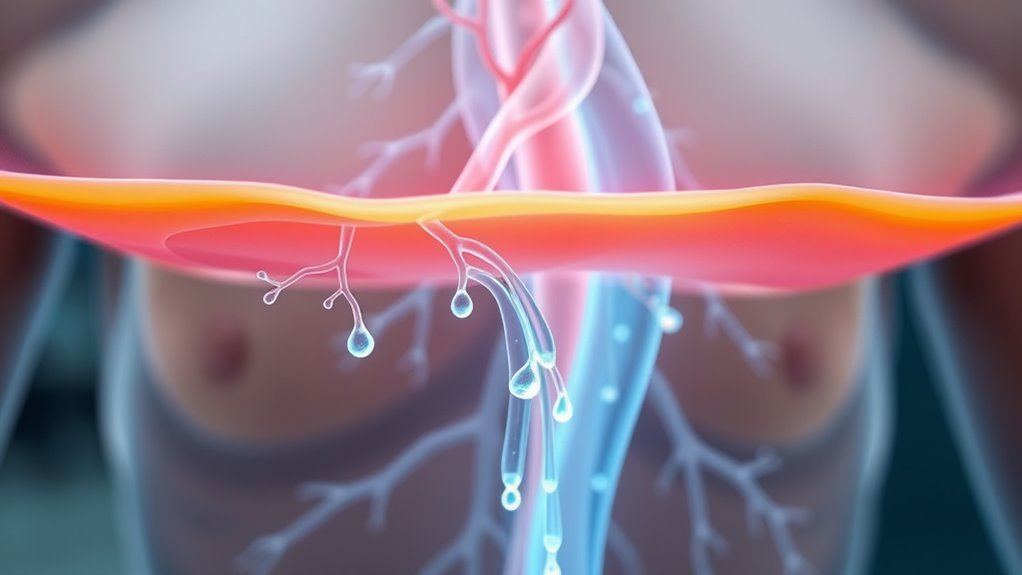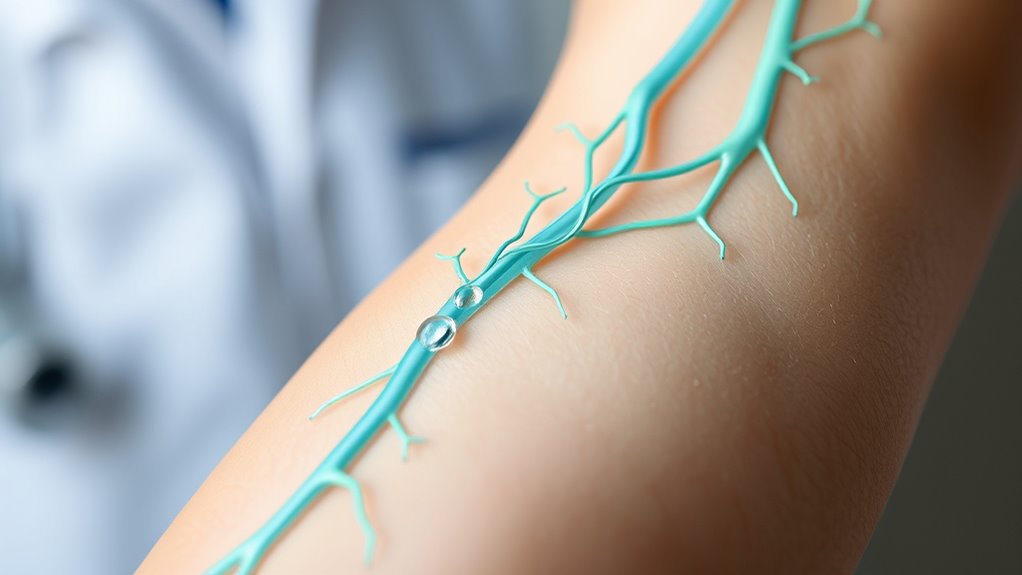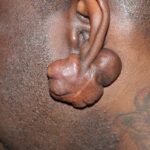Lymph leaks happen when lymph fluid escapes from injured or disrupted lymph vessels, often after surgeries involving lymph nodes. You might notice swelling, clear fluid drainage, or a feeling of discomfort in the area. To manage this, healthcare providers may recommend compression, drainage, or even surgical procedures to seal the leaks. If you want to learn how to prevent or treat lymph leaks effectively, keep exploring for useful tips and options.
Key Takeaways
- Lymph leaks occur when lymph fluid escapes from the lymphatic system into nearby tissues, often after surgeries involving lymph nodes.
- Symptoms include persistent swelling, clear fluid drainage, and formation of seromas at the surgical site.
- Conservative treatments like compression, drainage, and dietary changes are initial management strategies.
- Surgical options such as vessel ligation or tissue glue may be necessary if leaks persist or worsen.
- Post-op care involves following medical advice, wearing compression garments, keeping the site clean, and avoiding strain.

Lymph leaks occur when lymph fluid escapes from the lymphatic system into surrounding tissues or spaces, often leading to swelling and discomfort. This can happen after surgeries involving lymph nodes or lymphatic vessels, making it a common concern during post-op recovery. If you’ve recently undergone a procedure like lymph node dissection or other surgeries near your lymphatic pathways, understanding lymph leaks and their management is essential. These leaks are considered surgical complications, and their occurrence can prolong recovery, increase discomfort, and sometimes require additional interventions.
Lymph leaks are common after surgeries involving lymph nodes, causing swelling and discomfort during recovery.
During post-op recovery, your body begins to heal the surgical site, but sometimes, the lymphatic vessels don’t seal properly, resulting in lymph fluid leakage. This leakage can manifest as persistent swelling, a clear or slightly yellow fluid draining from the incision, or a collection of fluid known as a seroma. Recognizing these signs early helps you and your healthcare team address the issue promptly. Managing lymph leaks often involves conservative measures first, such as compression therapy to limit fluid accumulation and drainage, or dietary modifications to reduce lymph production. Sometimes, your doctor may recommend aspiration or the placement of a drain to remove excess fluid and prevent further swelling.
In some cases, surgical intervention becomes necessary if the leak persists or worsens. Surgeons might perform a procedure to ligate the leaking lymphatic vessels or apply tissue glue to seal the leak. These procedures aim to stop the fluid escape and promote healing, fostering a smoother post-op recovery process. The goal is to minimize complications, reduce discomfort, and restore normal function as quickly as possible. You should follow your healthcare provider’s instructions carefully during recovery, including wearing compression garments, keeping the incision clean, and avoiding activities that might strain the surgical site.
While lymph leaks can be frustrating, they are manageable with proper care and timely medical attention. It’s important to stay vigilant for symptoms like persistent swelling or unusual drainage. If you notice signs of a lymph leak, don’t hesitate to communicate with your healthcare team. Addressing these issues early can prevent complications, reduce recovery time, and help you return to your normal activities sooner. Remember, understanding the nature of lymph leaks and actively participating in your post-op care greatly improves your chances of a smoother, complication-free recovery. Recognizing that lymph leaks are linked to the lymphatic system can help you better understand why they occur and how to prevent or manage them effectively.
Frequently Asked Questions
Can Lymph Leaks Occur After Any Type of Surgery?
Yes, lymph leaks can happen after any surgery that involves lymphatic vessels. During postoperative care, it’s vital to monitor your wound for signs like swelling or fluid. Proper wound healing practices help reduce the risk of lymph leaks. If you notice persistent swelling or fluid leakage, contact your healthcare provider promptly to guarantee proper management and support ideal recovery. Staying vigilant during postoperative care is key to preventing complications.
Are Lymph Leaks Common in Specific Age Groups?
Think of age as a map guiding your health journey. Lymph leaks tend to be more common in older adults, where age-related risks weaken tissues, making leaks more likely. Conversely, pediatric concerns focus on delicate, developing bodies that require extra care. You’re more prone to lymph leaks if you’re in a specific age group, so knowing these risks helps you take proactive steps to protect yourself, no matter your age.
What Are the Signs Indicating a Lymph Leak?
If you notice signs like swelling or persistent wound drainage, it could indicate a lymph leak. Look for lymphedema symptoms such as swelling, heaviness, or tightness in the affected area. You might also see clear or watery fluid leaking from your wound or surgical site. These signs suggest that lymph fluid is escaping, and you should contact your healthcare provider promptly to evaluate and manage the situation effectively.
How Long Does It Take to Recover From a Lymph Leak?
Imagine a slow, steady stream of healing, yet sometimes setbacks happen. Your recovery timeline depends on the leak’s severity and your body’s response. Typically, symptom duration can range from a few days to several weeks, with some cases resolving quickly and others needing more time. Stay vigilant, follow your healthcare provider’s advice, and give your body the rest it needs. Your patience and care will guide your healing process.
Are There Long-Term Complications From Untreated Lymph Leaks?
If you leave a lymph leak untreated, you risk developing long-term issues like lymphatic damage and chronic swelling. This can lead to persistent discomfort, increased risk of infections, and potential tissue damage. It’s important to seek medical attention promptly to prevent these complications. Managing lymph leaks early helps preserve your lymphatic system’s health and reduces the chances of long-lasting problems. Ignoring symptoms can make recovery more difficult and extend your healing process.
Conclusion
To conclude, understanding lymph leaks helps you recognize symptoms early and seek prompt treatment. For instance, imagine a patient who develops persistent swelling after surgery; catching the leak early allowed for targeted drainage and recovery. By staying informed and consulting your healthcare provider promptly, you can effectively manage lymph leaks and prevent complications. Remember, early intervention makes all the difference in ensuring a smooth recovery and maintaining your health.
















